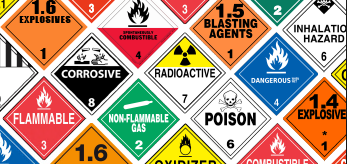
Hazardous Materials (hazmat) shipping is an activity that has the potential to pose significant risks. Any mistake or oversight (especially regarding DOT hazard class classification) on the part of a hazmat shipper, supply chain employee or carrier can lead to a serious accident that can endanger lives and/or cause property damage. This is why the United States’ Department of Transportation (DOT) has strict regulatory requirements for shipping hazardous materials by ground, air, or ocean.
The DOT has divided hazardous materials into nine different categories – commonly referred to as hazard classes – based on the level of potential hazard they pose. Title 49 of the United States Code of Federal Regulations (49 CFR) requires hazmat shippers to assign each hazardous material that is shipped to one of the DOT hazard class(es). Improper classification and identification of hazardous materials leaves the shipper open to a wide-range of potential consequences ranging from civil and criminal penalties to safety incidents and revocation of hazmat shipping rights.
DOT Hazard Class Breakdown
Let us now take a look at the nine DOT hazard classes
Hazard Class 1 – Explosives
This dot hazard class is further divided into six divisions:
1.1 Explosives (with a mass explosion hazard) (e.g. dynamite and blasting explosives)
1.2 Explosives (with a projection hazard) (e.g. weapons cartridges and hand grenades)
1.3 Explosives (with predominately a fire hazard) (e.g. flash powder and commercial-grade fireworks)
1.4 Explosives (with no significant blast hazard) (e.g. model rocket motors and consumer-grade fireworks)
1.5 Very insensitive explosives; blasting agents (e.g. ammonium nitrate-fuel oil mixture and very insensitive explosive articles)
1.6 Extremely insensitive detonating substances (e.g. extremely insensitive explosive articles)
Hazard Class 2 – Gases
This hazard class is further broken down into three divisions:
2.1 Flammable gas (e.g. spray paint and lighters)
2.2 Non-flammable compressed gas (e.g. oxygen generators and shock absorbers)
2.3 Poisonous gas (e.g. Chlorine Gas and Phosgene Gas)
Hazard Class 3 – Flammable Liquids
Examples of common flammable liquids include perfumes and paint
Hazard Class 4 – Flammable Solids
This hazard class includes three divisions of hazardous materials:
4.1 Flammable solid (e.g. match sticks and desensitized solid explosives)
4.2 Spontaneously combustible material (e.g. Aluminum borohydride, oily rags)
4.3 Dangerous when wet material (e.g. Barium and lithium metal)
Hazard Class 5 – Oxidizing Substance and Organic Peroxide
This hazard class is comprised of two divisions of hazardous materials:
5.1 Oxidizer (e.g. hydrogen peroxide and calcium chlorate)
5.2 Organic Peroxide (e.g. Ammonium nitrate fertilizers and hardeners or accelerators)
Hazard Class 6 – Poisonous/Toxic and Infectious Substance
This dot hazard class contains two divisions of hazardous materials:
6.1 Poisonous/Toxic material (e.g. nicotine and arsenic)
6.2 Infectious substance (e.g. Covid19 test samples and regulated medical waste)
Hazard Class 7 – Radioactive Material
Examples of radioactive substances include exit signs containing tritium and nuclear fuels
Hazard Class 8 – Corrosive Material
Examples of this dot hazard class include corrosive materials are lead acid batteries and degreasers
Hazard Class 9 – Miscellaneous Hazardous Material
Examples include airbag modules, lithium batteries and substances that pose environmental hazards
The Importance of Properly Classifying Hazardous Materials
Each DOT hazard class has its own regulatory requirements in terms of how the materials are required to be packed, marked, labeled and documented. Additionally, these requirements also depend on the mode of transportation used.
As mentioned previously, if a hazmat shipment is assigned incorrectly to one of the nine DOT hazard classes, it usually results in a cascade of regulatory errors that cause the chances of a transportation incident to greatly increase. Failing to comply with federal hazmat regulations can also have other serious consequences such as shipping delays, carrier-imposed fines, government-imposed fines, jailtime and revocation of shipping rights.
Therefore, the DOT mandates hazmat training for any participant who performs a transportation or pre-transportation function, when shipping hazardous materials by ground, air, or ocean. Depending on the type of hazardous materials you handle or ship and the mode of transportation used, you might be required to undergo an IATA, 49 CFR, IMDG or multimodal training program.
The Best Place to Learn about Hazard Classes and Their Regulatory Requirements
Hazmat University provides online hazardous materials and dangerous goods training for all modes of transport and materials requiring special handling. Our online courses are also designed to comply with international regulations for shipping dangerous goods. To learn more, call us at (844) 532-7634 /(609) 860-0300 or contact us online.